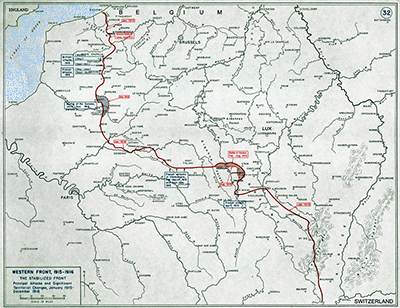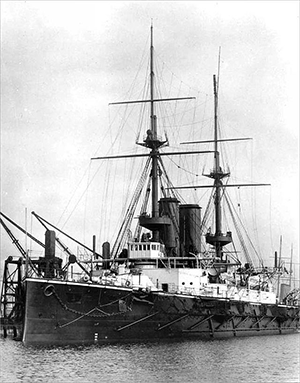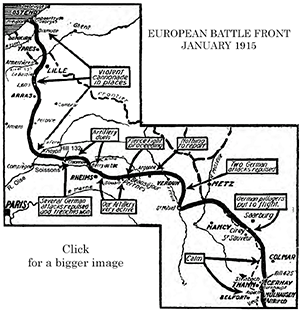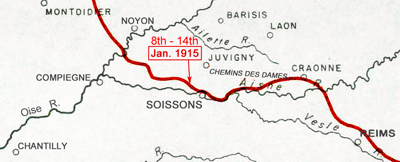First World War Project
Home News - January 1915
 The Western Front "stabilised" from January 1915 to the end of 1916 but fighting continued throughout the period, with some particularly large and hard-fought battles, intended to make a breakthrough. Many of these "breakthrough" battles have become part of the language of the First World War. The conflict now straddled the globe where the European Empires touched. Increasingly, the Home Front news also included accounts of naval battles around the globe, lost naval and merchant ships, and submarine attacks and losses.
The Western Front "stabilised" from January 1915 to the end of 1916 but fighting continued throughout the period, with some particularly large and hard-fought battles, intended to make a breakthrough. Many of these "breakthrough" battles have become part of the language of the First World War. The conflict now straddled the globe where the European Empires touched. Increasingly, the Home Front news also included accounts of naval battles around the globe, lost naval and merchant ships, and submarine attacks and losses.
| Daily Express of 2nd January 1915 | |||||||||||||||||||||
THE BALANCE SHEET.
|
First Naval Loss - H.M.S. Formidable
 On New Year's Day, H.M.S. "Formidable", a pre-dreadnaught battleship was sunk by German submarine, U-24, in the English Channel off Portland Bill. U-24 was one of the most successful U-boats that survived the war. "Formidable" also defined a class of pre-dreadnaught battleships. As sister ship to the Bulwark, the loss was felt keenly in and around Sheerness.
On New Year's Day, H.M.S. "Formidable", a pre-dreadnaught battleship was sunk by German submarine, U-24, in the English Channel off Portland Bill. U-24 was one of the most successful U-boats that survived the war. "Formidable" also defined a class of pre-dreadnaught battleships. As sister ship to the Bulwark, the loss was felt keenly in and around Sheerness.
The South Eastern Gazette reported on 5th January 1915: "SURVIVORS OF THE FORMIDABLE. There appears to be little doubt now that of the officers and crew of the battleship Formidable, which, as reported on page 3, was sunk in the Channel on the morning of New Year's Day, only 201 have been saved. The ship went down between 3 and 3.30. There were from 700 to 800 men on board at the time. Of the four boats launched, one, a barge, capsized and several men were thrown out, the second, also a barge, got away with about 70 men, who were picked up by a light cruiser; the third, a pinnace, also with some 60 men, got ashore at Lyme Regis, and the fourth, a launch, with 70 men, after being in a rough sea for about 11 hours, was rescued about 15 miles off Berry Head by the trawler Providence, and brought into Brixham. Survivors have given graphic accounts of the foundering of the battleship and of their terrible experiences.
Our Sheerness correspondent writes: The sinking of the Formidable is another tragic blow to the Medway forts. She was a sister ship to the Bulwark and was lying moored in this harbour when that ship was destroyed by explosion at the end of November. The actual loss of life experienced in Sheerness homes by the foundering of the Formidable is difficult to ascertain, but it is feared that it will be heavy when the full lists of casualties are published. Although manned from Chatham Depot, there is always a fair percentage of married men in the Nore Division ships make their homes in this port, especially amongst the warrant and petty officer ratings."
TWIST IN THE TALE..... HMS Formidable deserter from 1910 in custody as ship sinks
Reported in the Daily Express on 5th January 1915. SAFE IN GOAL. Patrick Mackin, a ship's fireman, was charged at West Ham yesterday with being a deserter from H.M.S. Formidable, which sank in the Channel on New Year's-day.
The man gave himself up on December 22 on his return from a foreign voyage, saying he left the Formidable when she was at Sheerness in August 1910. After a week's remand the Admiralty had not sent the required information, and he was further remanded to Brixton Gaol.
Inspector Eade yesterday stated that the Admiralty had asked that Mackin be sent back to the naval depot, and he therefore asked for the discharge of the man.
"If you had been sent back last week," said Mr. Gillespie, "you would possibly have been at the bottom of the sea by now."
2nd January: Recruits for Service in the Colonies - see the world.....
| Whitstable Times and Herne Bay Herald on 2nd January 1915 |
| "RECRUITING - TO THE EDITOR. Dear Sir, The 4th Reserve Battalion "The Buffs" East Kent Regiment want a few more recruits (married or single) to make up their full strength before going on active service to one of our Colonies. Here is a splendid Opportunity offered to men who have a desire to see something of the world and who, if they miss this opportunity now, may have no other such chance, but may later, however, have to join the Army. Call on Corporal Kennedy, 31, Albert Street, Whitstable. Thank you in anticipation." |
3rd January: Local Reservists: reported deaths
| South Eastern Gazette on 12th January 1915 |
| "DEATHS OF NATIONAL RESERVISTS. Three members of the Company of National Reserves quartered at the Congregational Hall, Faversham, have recently died. They are Private Thomas Wright and Private James Kirby, both of Maidstone, and Private Ernest George Price, of Canterbury. The two Maidstone men died in the Faversham Military Hospital, Kirby on Sunday, January 3rd, and Wright on the 30th Ult. Their bodies were conveyed to Maidstone for burial. Private Price died at his home at Canterbury, and his death was the subject of an inquest held at Canterbury on Monday, the verdict being "Death from natural causes." |
† - Fifth Loss in the Kingsdown with Creekside Benefice - 7th January, registered in Faversham - "On Home Service"
Sidney Francis (also "Frances") Kite (of Doddington), Killed on Home Service, aged 33 years |
11th January: Petty Crimes in Lynsted Village
| South Eastern Gazette on 12th January 1915 |
| STOLEN JEWELLERY - Edith Louisa Kemp, a young domestic servant, belonging to Lynsted, was charged with stealing a gold bracelet and a gold diamond ring, valued at £15 10s., the property of Mrs. Murdock, the wife of the Headmaster of Borden Grammar School, between June and October. The articles had been pawned for 10s. with Messrs. Croft, Sittingbourne. Prisoner pleaded guilty, and was bound over for twelve months. [The court case was heard on 11th January] |
... and nearby in Oare/Luddenham
| South Eastern Gazette on 26th January 1915 |
| FAVERSHAM COUNTY POLICE COURT. Ernest Lennard, 17, of Oare, pleaded guilty to stealing a quantity of potatoes, value 1s. 6d., at Loddenham [sic], the property of Mr. Percy French, on January 11th. As it was a first offence the Bench bound prisoner over. |
The European Battlefront - Soissons and other 'hot spots'
100 Jobs Lost as Conyer Brick-making shuts down
Only a very short newspaper item that may, in part, explain the high level of recruitment in our villages.
| Faversham and North East Kent News, 16th January 1915. |
| TEYNHAM: Messrs. Eastwood and Co have closed for an indefinite period, their brickworks at Conyer, Teynham. This course has been taken owing to the great falling off in the demand for bricks caused by the war. About 100 employees are affected---- |
Raising Reserve units - R.G.A. Heavy Battery
| Reported by Kent Messenger on 16th January 1915. |
| The Kent Territorial Forces Association is making an effort, which promises to meet with success, to raise a reserve unit of the Home Counties Kent R.G.A. [Royal Garrison Artillery] Heavy Battery from the Chatham and Faversham recruiting area, which embrace the Isle of Sheppey. |
SOCIETY NOTE:-
 The formation of voluntary artillery corps was frequently raised in Government circles from 1857 - with initially lukewarm response from Parliament. Investment in earthworks and buildings was eventually voted on for several strategic points stretching from Liverpool, through Rochester to Faversham. The first Faversham Voluntary Artillery Corps was given Royal Assent at the close of 1859 after several Parliamentary debates from August. The Faversham Corps was sworn in at Faversham Town Hall on Saturday 3rd December 1859. Lieutenant Munn swore in 52 volunteers with initial plans for a battery of 20 guns. Drill took place on Saturdays. Volunteers were drawn from surrounding hamlets, villages and the main town of Faversham, which was an historic focus for the production of gunpowder/gun cotton for munitions. The Headquarters was in Preston Street and quickly grew with a second corps to a total of 80 volunteers. The artillery site was a frequent host for annual great gun competitions in following years. So, there was a long-standing commitment to volunteer artillery training nearby to us.
The formation of voluntary artillery corps was frequently raised in Government circles from 1857 - with initially lukewarm response from Parliament. Investment in earthworks and buildings was eventually voted on for several strategic points stretching from Liverpool, through Rochester to Faversham. The first Faversham Voluntary Artillery Corps was given Royal Assent at the close of 1859 after several Parliamentary debates from August. The Faversham Corps was sworn in at Faversham Town Hall on Saturday 3rd December 1859. Lieutenant Munn swore in 52 volunteers with initial plans for a battery of 20 guns. Drill took place on Saturdays. Volunteers were drawn from surrounding hamlets, villages and the main town of Faversham, which was an historic focus for the production of gunpowder/gun cotton for munitions. The Headquarters was in Preston Street and quickly grew with a second corps to a total of 80 volunteers. The artillery site was a frequent host for annual great gun competitions in following years. So, there was a long-standing commitment to volunteer artillery training nearby to us.
The position of Harty Ferry gave coverage for approaches to Sheerness (and helped secure Faversham's cotton powder works, from which many volunteers were drawn). The photograph shows modern-day remnant of a gun earthwork.
First set up in 1908 with its own ammunition column, this Heavy Gun Battery served in the UK until early 1915 when it was deployed as a 4-gun Battery armed with 4.7" (qf) Field Guns.
The Kent Messenger added in its report of 16th January 1915: "The Kent Territorial Forces Association is making an effort, which promises to meet with success, to raise a reserve unit of the home Counties Kent R.G.A. Heavy Battery from the Chatham and Faversham recruiting area, which embraces the Isle of Sheppey."
† - Sixth Loss in the Kingsdown with Creekside Benefice - 22nd January, registered in Gillingham - "On Home Service" (H.M.S. Albermarle in Sheerness)
Henry Burley (of Luddenham), Died on Home Service (ship in Sheerness), aged 44 years |
East Kent Farmers' Club - Children for Farm Work
| Dover Express on 22nd January 1915 and Folkestone, Hythe, Sandgate & Cheriton Herald on 23rd January. |
| Mr. A.W. Wood was on Saturday elected to succeed Mr. William Harvey in the chairmanship of the Canterbury Farmers' Club and East Kent Chamber of Agriculture. The new vice-Chairmen are Mr. Daniel Brice and Mr. George Mount, the well-known rosarian. Who was last year Mayor of Canterbury. The name of Mr. H.G. Chambers, from the Maidstone district, was added to the roll of members. ......... An interesting debate took place on the question whether facilities should be given for boys of twelve years and upwards to work on farms during the war, which is one of the subjects to be considered at the next meeting of the Central Chamber. Mr. Allington Collard considered that in many cases it would be most useful if permission were given. So many of the younger men had been called up to the Colours that there was undoubtedly a shortage of labour, and with the present prices of food, etc., the money earned would be very useful to the families of labouring people. Mr. J.D. Maxted advocated that similar facilities should be asked for in the case of girls, whose services in hop training and fruit picking were, if anything, more useful than those of the boys. Their schooling would only be interfered with during the period of the war. Mr. Alfred Amos did not think that the children's schooling should be interrupted. He had, however, for several years employed the boys on Saturdays. |
Children working on farms - possible exemption from schooling
| The Times on 27th January 1915 |
| CHILDREN ON FARMS - WORK AND THE SCHOOL AGE. - SUGGESTED EXEMPTION. The deficiency of labour for farming purposes was considered at a meeting of the Council of the Central and Associated Chambers of Agriculture held at the Surveyor's Institution yesterday. The subject is to be more fully discussed at the next meeting on February 23. Captain C. Bathurst, M.P., was in the chair, and there were also present Lord Channing and Major-General Sir Ivor Herbert, M.P. The Business Committee presented a report stating that a letter had been received from the Board of Agriculture, in which it was intimated that the Board were satisfied that the deficiency of farm labour had become very serious in certain districts, if not throughout the country generally, and that the time had arrived when farmers must take concerted action to deal with the situation, if they were to carry on their business with profit to themselves and in the interests of the nation. Pending discussion at the next meeting the report was formally received. The Education Committee reported their opinion that boys of 12 years of age employed solely on farms might be exempted from school attendance during the war, but that they should afterwards return to school at the earliest possible period. The committee hoped that the boys exempted might be enabled at some subsequent period to attend continuation classes of agricultural or other suitable schools. LORD CHANNING, who moved the adoption of the report, said he did not see why the boys of England should not be called upon to take their share of public duty in the present crisis. The report would dispose of any idea that they wished to cut short the educational life of the rural child in order to get cheap labour for the farms. Mr. WOOD, speaking as a representative of Kent farmers, urged that girls as well as boys should be included in the recommendation of the committee for school exemption. In hop districts girls were as useful as boys. THE CHAIRMAN supported the suggestion. Not many years ago our young women did admirable work in milking cows. They could not take up any more patriotic task at present. He would be sorry himself to confess he had not a wife who could milk a cow as well as any labourer in his employment. (Laughter.) A letter was read from the Board of Education stating that they had no power to give any general directions overriding the ordinary law with regard to school attendance, but that the local education authority was under no obligation to take proceedings for non-attendance if they were satisfied that there was a reasonable excuse. The report was adopted with the substitution of the word "children" for "boys". |
ARTEFACTS - Background Records...................
8th - 14th January 1915: The Battle of Soissons.
A brief and ferocious battle as the French tried to secure a 132-metre hill (Hill 132) but had to retreat after the River Aisne was flooded, destroying bridges to the rear of French forces. Only after they were able to construct replacement bridges were they able to retreat. Illustrated London News Report "The Battle of Soissons: Aisne Floods and Bombarded Buildings." Illustrated London News [London, England] 6 Feb. 1915: 184."
MEN SERVING FROM CREEKSIDE
| Faversham and North East Kent News 12th December 1914. |
LOCAL MEN ON ACTIVE SERVICE NORTON LYNSTED TEYNHAM James Saunders, Private, Army Service Corps; Gerard P. Selby (M.B. Oxon), Lieutenant, R.A.M.C.; R.P. Selby, Sub-Lieut, R.N.; --------- Shufflebotham, A.B.; F.E. Smith, stoker; Reginald Lewis Smith, trooper, East Kent Yeomanry; George Thomas Swan, chief stoker. 2nd January 1915 16th January 1915 6th February 1915 |


 From Soissons to Reims there were artillery duels. Our heavy guns made effective reply to the batteries and trench mortars of the Germans.
From Soissons to Reims there were artillery duels. Our heavy guns made effective reply to the batteries and trench mortars of the Germans. World War 1 Pages
World War 1 Pages